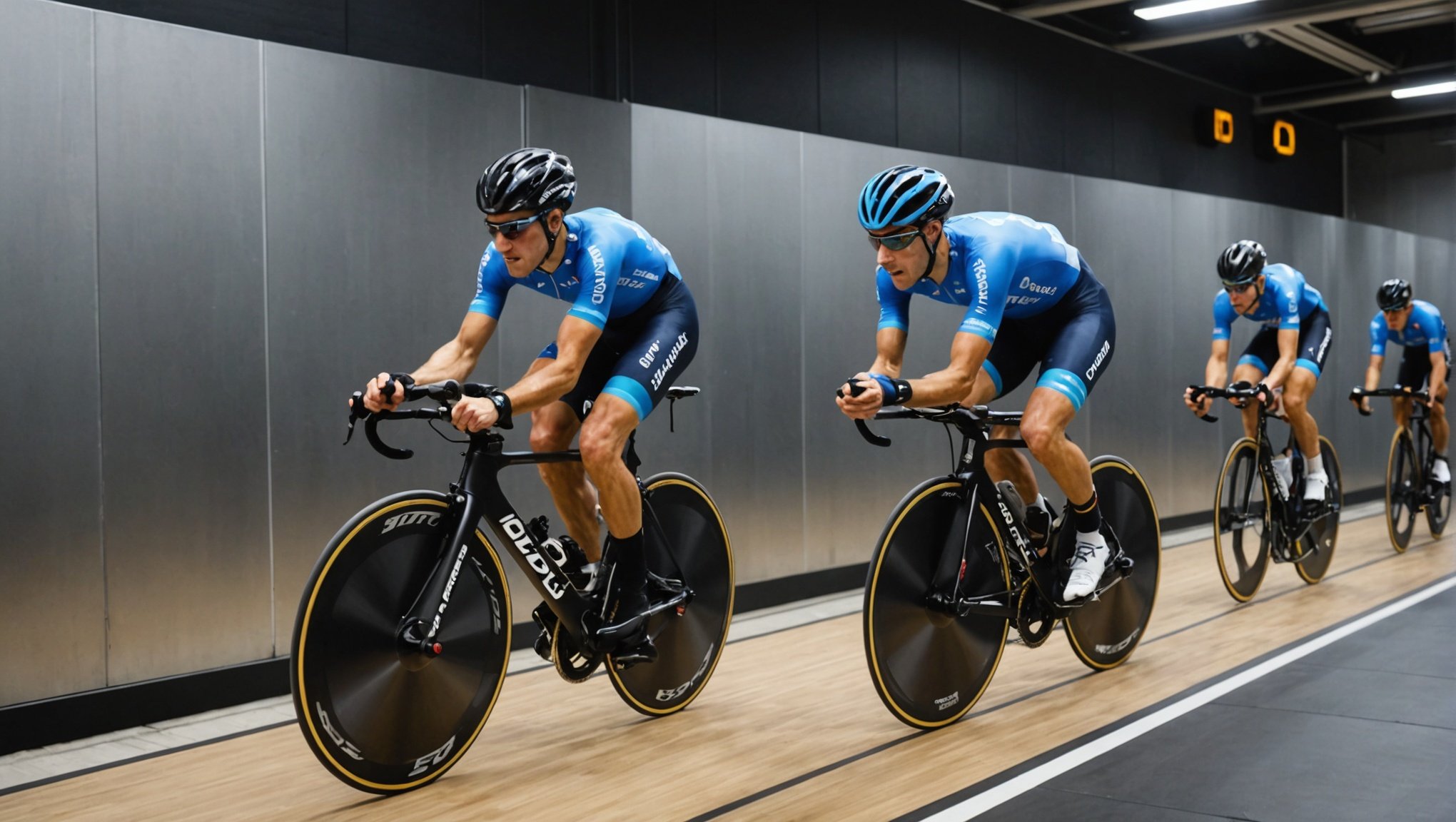The pursuit of speed in cycling drives UK teams to harness cutting-edge technologies, with wind tunnel testing being a pivotal asset. By simulating real-world conditions, these teams refine aerodynamics to enhance performance and efficiency. This innovative approach not only shortens race times but also provides insights that can be crucial for competitive edge. Discover how wind tunnel testing is revolutionizing the cycling landscape, propelling athletes to new heights.
Principles of Wind Tunnel Testing
Wind tunnel testing is a crucial method for evaluating aerodynamics and enhancing cycling performance. By simulating real-world conditions, wind tunnels provide a controlled environment where variables such as wind speed and direction can be precisely managed. This allows for accurate assessment of how different factors influence a cyclist's speed and efficiency.
Also to discover : Discover pick up soccer matches near you with poteau app
Simulating Real-World Conditions
Wind tunnels recreate the conditions a cyclist faces on the road, offering insights into how air flows around the body and bike. This simulation helps in understanding drag forces and their impact on cycling performance. The ability to control these conditions ensures that tests are repeatable and reliable, providing consistent data for analysis.
Key Aerodynamic Principles
Several aerodynamic principles are pivotal in wind tunnel testing. The reduction of drag is a primary focus, as it directly affects a cyclist's speed. By analyzing the interaction between the cyclist and airflow, adjustments can be made to improve posture, equipment, and clothing, all of which contribute to enhanced aerodynamics.
Also to read : Unlocking Peak Performance: The Role of UK Sports Psychologists in Conquering Athlete Anxiety
Importance of Controlled Environments
The controlled environment of a wind tunnel eliminates external variables that could skew results. This precision is essential for developing strategies to reduce drag and optimize cycling performance. By isolating specific elements, researchers can focus on individual aspects of aerodynamics, leading to targeted improvements and innovations in cycling technology.
Benefits of Wind Tunnel Testing for Cycling Teams
Wind tunnel testing offers significant benefits for cycling teams, primarily through its impact on drag reduction and speed enhancement. By meticulously analyzing how air flows around the cyclist and bicycle, teams can make informed adjustments to minimize drag. This leads to noticeable improvements in cycling efficiency and overall performance.
Optimizing Rider and Bike Positioning
A key advantage of wind tunnel testing is its role in optimizing rider and bike positioning. Cyclists can experiment with different postures and configurations to find the most aerodynamic setup. This process is crucial for maximizing speed and efficiency, as even minor adjustments can have a substantial impact on performance.
Cost-Effectiveness of Aerodynamic Testing
Compared to other aerodynamic testing methods, wind tunnel testing is notably cost-effective. While it requires an initial investment, the precision and repeatability of the data obtained make it a valuable tool for long-term performance improvement. Cycling teams can achieve targeted enhancements without the ongoing expenses associated with real-world testing, making it a strategic choice for optimizing performance.
Case Studies of UK Cycling Teams
Exploring the impact of wind tunnel testing on UK cycling teams offers valuable insights into its role in enhancing performance. By examining specific success stories, we can understand the practical benefits of this technology.
Analysis of a Top UK Cycling Team's Wind Tunnel Testing Results
A leading UK cycling team recently conducted extensive wind tunnel testing to refine their performance metrics. The results revealed significant reductions in drag, leading to improved speed and efficiency. The tests highlighted the importance of optimizing rider positions and equipment to achieve these gains.
Insights from Coaching Staff and Engineers on Implementation
Coaching staff and engineers emphasized the strategic implementation of wind tunnel findings. They noted that understanding the dynamics of airflow around the cyclist and bike was crucial for making precise adjustments. This collaboration between technical experts and athletes facilitated the translation of data into actionable performance improvements.
Comparison of Performance Before and After Wind Tunnel Testing
Comparing performance metrics before and after wind tunnel testing showcased noticeable enhancements. The team observed a measurable increase in speed and a reduction in energy expenditure during races. These improvements underscore the value of wind tunnel testing in achieving competitive advantages for UK cycling teams.
Technical Methodologies in Wind Tunnel Testing
Wind tunnel testing employs a variety of technical methodologies to ensure precise and reliable outcomes. These methodologies are crucial in aerodynamics testing, providing insights that drive performance improvements.
Overview of Common Testing Setups and Equipment
Testing setups in wind tunnels are meticulously designed to replicate real-world cycling conditions. This involves using advanced equipment like force balances, pressure sensors, and flow visualization tools. Each component plays a vital role in measuring and analyzing aerodynamic forces, enabling a comprehensive assessment of a cyclist's performance. The accuracy of these setups is paramount, as it directly impacts the reliability of the data collected.
Discussion of Data Collection and Analysis Techniques
Data collection in wind tunnel testing is a sophisticated process that involves capturing a multitude of variables. High-speed cameras and sensors record airflow patterns and forces acting on the cyclist and bike. This data is then subjected to rigorous data analysis techniques, where computational models and simulations are used to interpret the results. By employing these methods, teams can identify specific areas for improvement, such as reducing drag or optimizing rider positioning.
Importance of Iterative Testing and Refinement in the Process
Iterative testing is a cornerstone of effective wind tunnel testing. It involves repeatedly testing and refining setups based on initial findings. This process allows for continuous improvement, as each iteration provides new insights into aerodynamic performance. By adopting this approach, cycling teams can make incremental adjustments that lead to significant gains in speed and efficiency. The commitment to refinement ensures that the benefits of wind tunnel testing are maximized, resulting in enhanced competitive performance.
Tips for Implementing Wind Tunnel Testing
Implementing wind tunnel testing effectively requires meticulous preparation and strategic application of results. Here are some implementation tips to optimize the process for cycling teams.
Best Practices for Preparing Athletes and Equipment
Before entering the wind tunnel, athletes should undergo thorough preparation. This includes ensuring that equipment is finely tuned and that cyclists are familiar with the testing procedures. Calibration of sensors and equipment is crucial to gather accurate data. It is also beneficial to simulate the testing environment during training sessions to acclimatize athletes to the conditions they will face.
Strategies for Interpreting and Applying Test Results
Once the testing is complete, the focus shifts to interpreting the data. Analyzing the results requires a collaborative effort between engineers and coaching staff. By understanding the nuances of the data, teams can identify specific areas for cycling optimization. For instance, pinpointing high-drag zones can lead to targeted adjustments in posture or equipment. Applying these insights systematically will ensure that performance improvements are realized.
Recommendations for Integrating Findings into Training Programs
Integrating wind tunnel findings into training programs is essential for maximizing benefits. Coaches should develop tailored training plans that incorporate the cycling optimization strategies identified during testing. This might involve specific drills to refine riding positions or the use of modified equipment in practice sessions. By embedding these strategies into regular training routines, teams can maintain a competitive edge and continuously enhance their performance.






